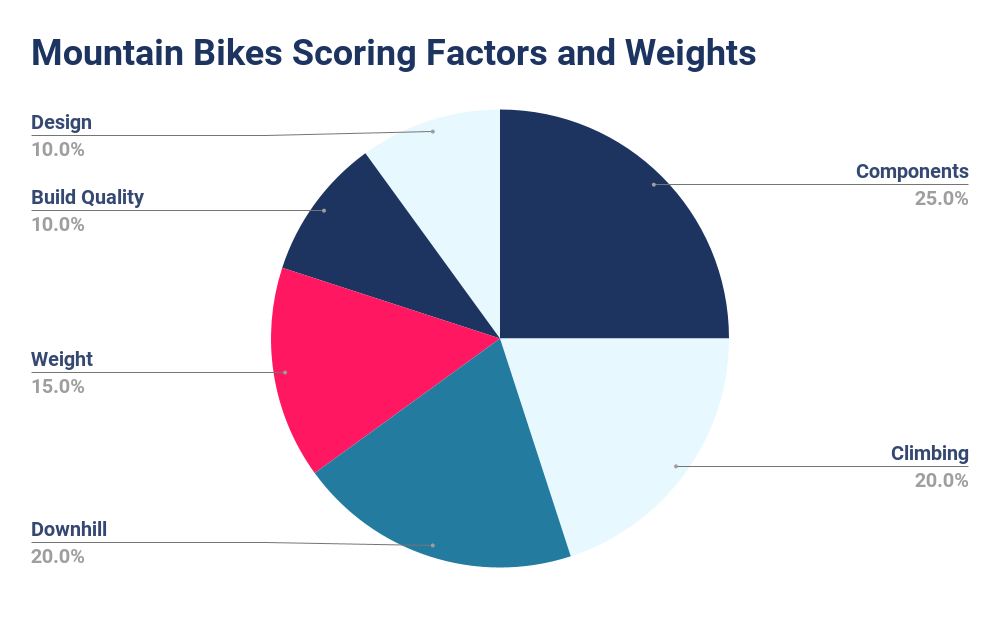On this page, I explain how I score mountain bikes so you get a better idea of the details. Each category’s results contribute to my overall verdict on the mountain bike’s quality, which looks as follows:
Components 4/5 | Climbing 4/5 | Downhill 3/5 | Weight 2/5 | Build Quality 4/5 | Design 2/5 | WEIGHTED OVERALL SCORE 3.3/5
Scores 1–2.5 are RED, 2.6–3.9 are ORANGE, and 4–5 are GREEN.
I score the following criteria on a scale from 1-5 based on in-depth market research, which includes evaluating my and other owners’ experiences and comparing the bike’s components with competing alternatives. The scores are weighted, meaning each feature has a different importance. For example, the components are more important than the design.

I approach each bike as objectively as possible. However, like everyone, I am subject to biases and expectations.
Scoring Criteria for Mountain Bike Features
Below is the list of the features of mountain bikes with an explanation of the scoring.
Components
The components hide several important features. The first is gearing. Modern mountain bikes generally use 1by gearing for simplicity and lower weight. 3by and 2by gears are a relic of mountain bikes that I believe will soon disappear. They can be found especially on cheaper bikes.
As for the groupset itself, I distinguish whether it is mechanical or electronic or if it is a combination of different groupsets.
I also look at the suspension fork, brakes, and their quality based on 3rd party reviews. I evaluate these criteria based on the price category of the bike.
This criterion has a relatively high weighting because it combines several important features.
- 1 – E.g., a bike with 3X shifting, short suspension travel, and low-quality brakes.
- 2
- 3
- 4
- 5 – E.g., the bike has high-quality components.
Climbing
Mountain bike geometry, suspension, and weight impact climbing (riding uphill) the most. Cross-country bikes with a rigid rear frame (hardtail) are ideal for climbing because their geometry allows easy pedaling even on steep inclines.
On the other hand, downhill bikes, designed primarily for extreme descents, are not suitable for uphill riding. Their geometry and suspension are optimized for handling challenging terrains and high speeds during descents, which is inefficient for pedaling uphill.
The bike’s overall weight also affects climbing, but I don’t consider it in this criterion as it has its own criterion.
- 1 – E.g., downhill or fat mountain bikes.
- 2
- 3
- 4
- 5 – E.g., cross-country mountain bikes.
Downhill
Downhill (downhill riding) is the opposite of uphill riding. These metrics kind of cancel each other out. For fast downhill riding, it’s good to have downhill or enduro geometry and air suspension on both the front fork and rear triangle.
I also check whether the bike is equipped with a telescopic seatpost, which is useful on descents.
A higher overall weight will reduce the bike’s controllability but will help you gain more speed. However, as with climbing, I don’t consider weight due to the separate criteria.
- 1 – E.g., cross-country mountain bikes with spring or no suspension.
- 2
- 3
- 4
- 5 – E.g., downhill or enduro mountain bikes with air suspension.
Overall Weight
Nobody likes heavy bikes. That’s why the overall weight is part of this scoring as well. Remember that cheaper bikes are made of heavier materials. Also, the scoring is different for hardtail and full-suspension bikes because the latter are heavier on average.
- 1 – 15.5 kg and more
- 2 – [14–15.5 kg)
- 3 – [12.5–14 kg)
- 4 – [11–12.5 kg)
- 5 – Below 11 kg
Build Quality
When evaluating build quality, I look at photos of details, especially welds, as well as reviews from other customers and their longer-term experiences. For some bikes, build quality only becomes apparent in the longer term, in which case longer-term reviews and the experiences of others are irreplaceable.
- 1 – E.g., the bike has serious manufacturing defects.
- 2
- 3
- 4
- 5 – E.g., the bike is built with attention to detail.
Design
Design is highly subjective, but I have to like the bike I ride. That’s why I’ve included it to a small extent. I look primarily at how the bike feels to me as a whole, whether the manufacturer pays attention to detail, whether the cable routing is hidden, etc.
- 1 – Old-looking bike without too much effort from designers.
- 2
- 3
- 4
- 5 – Modern-looking bike designed with an attention to detail.
Conclusion
I hope you now have a better idea of how I review mountain bikes. I aim to help buyers like you make educated buying decisions.
Please remember that I am still tweaking and improving this process to provide you with the most valuable information possible.
I am open to feedback on how to improve this system. Feel free to contact me with suggestions.
Recent Updates
- Jan 24, 2024: V1.0 scoring introduced.
